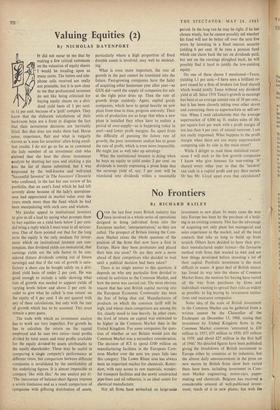Valuing Equities (2)
By NICHOLAS DAVENPORT
My jocular appeal to institutional investors to give us all a lead by saying what prompts them to buy equities on a yield basis below 2 per cent. did bring a reply which I must treat in all serious- ness. One of them pointed out that for the long term the equity is the only medium for invest- ment which an institutional investor can con- template, that dividend yields are immaterial, that earnings yields are the sole factor to be con- sidered (future dividends coming out of future earnings) and that if the rate of growth is satis- factory a share can be bought safely on a divi- dend yield basis of under 2 per cent. He was good enough to include a table showing what Tate of growth was needed to support yields of varying levels below and above 2 per cent. in order to give what he called 'a true return' on the equity of 6 per cent. I do not quarrel with any of these calculations, but only with the rate of growth which has to be assumed. This must remain a pure guess.
The tools with which an investment analyst has to work are very imperfect. For growth he has to calculate the return on the capital employed and he uses two ratios—total profits divided by total assets and total profits available for the equity divided by assets attributable to the equity shareholder. These may be useful in comparing a single company's performance at different times, but comparison between different companies is invalidated by the unreliability of the underlying figures. It is almost impossible to compare 'like with like.' As one analyst put it: 'The inaccuracy of. balance-sheet figures imposes a severe limitation and as a result comparison of .:;ompanies with differing distribution of assets, particularly where a high proportion of fixed durable assets is involved, may well be mislead- ing.'
What is even more important, the rate of growth in the past cannot be translated into the future. Fast-growing companies have the habit of acquiring other businesses year after year—as GUS did—until the supply of companies for sale at the right price dries up. Then the rate of growth drops suddenly. Again, capital goods companies, which have to spend heavily on new plant from time to time, progress unevenly. Their units of production are so large that when a new plant is installed they often have to endure a period of over-supply—as is happening today in steel—and lower profit margins. So, apart from the difficulty of guessing the future rate of growth, the poor investment analyst has to guess the rate of profit, which is even more impossible. He might just as well take up astrology.
What the institutional investor is doing when he buys an equity to yield under 2 per cent. on dividends is merely expressing a pious hope that the earnings yield of, say, 5 per cent. will be translated into dividends within a reasonable period. In the long run he may be right, if he has chosen wisely, but he cannot possibly tell whether his fund will not be better off over the next five years by investing in a fixed interest security yielding 6 per cent. If he runs a pension fund which can claim back the tax on dividends paid, but not on the earnings ploughed back, he will possibly find it hard to justify the low-yielding equity.
On one of these shares I mentioned—Tesco, yielding 1.1 per cent.—I have seen a brilliant re- port issued- by a firm of brokers (on food shares) which would justify Tesco without any dividend yield at all. Since 1954 Tesco's growth in earnings has been at an average annual rate of 39 per cent., but it has been cleverly taking over other stores and converting them to supermarkets or self-ser- vice. When I read calculations that the average supermarket of 4,000 sq. ft. makes sales of 30s. per square foot per week with a profit margin of not less than 4 per cent. of annual turnover, I am not really impressed. What happens to the profit margin when there are too many supermarkets competing side by side in the main street?
While I delight to read these statistical excur- sions I will stick to the few growth companies I know who give bonuses (in non-voting 'A' shares) every other year so that the 'insiders' can cash in a capital profit and pay their surtax. Or has Mr. Lloyd upset even that calculation?














































 Previous page
Previous page